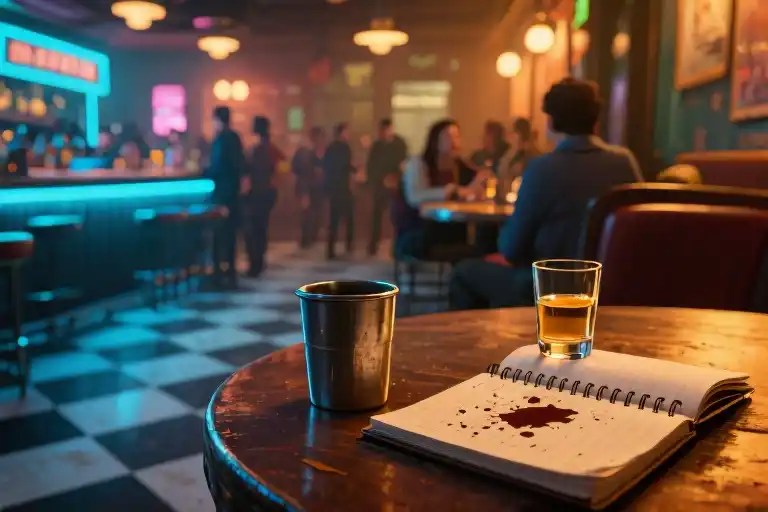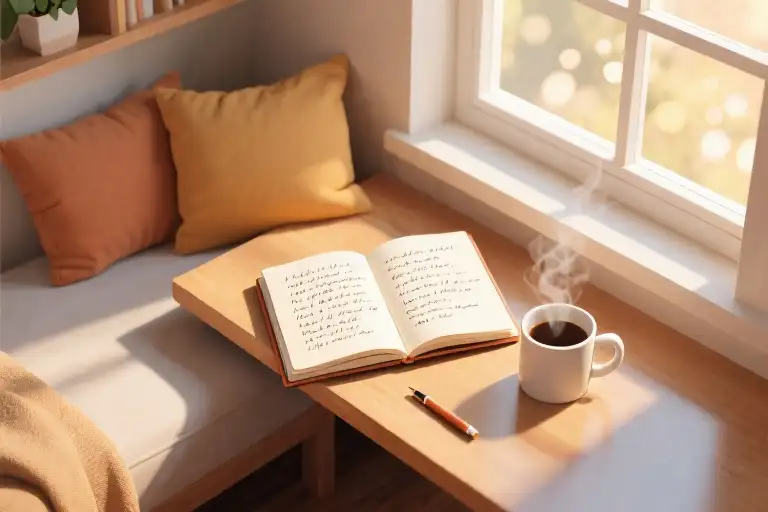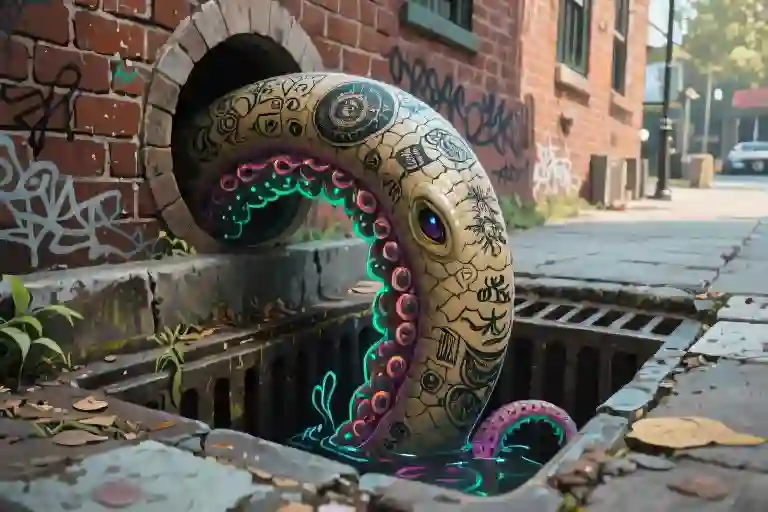The metallic chime of pewter cups clinking against Don Julio bottles reverberates through the dimly lit space, a sound that carries both the weight of ritual and the promise of forgetting. Half the bar exists in a blue haze, the other half submerged in gray—a living gradient stretching between melancholy and restlessness, where the air hums with Kendrick Lamar’s rhythms pulsing against eardrums like a second heartbeat. Between these sensory extremes, time folds in on itself: a white-haired man’s bomber jacket catches the light, checkered floors tilt underfoot, and the bartender’s absent scratching at his back becomes a metronome for the evening’s unraveling.
In this liminal space, notebooks open themselves. Dried ink blots transform into constellations of meaning, their full circles whispering secrets about the people orbiting the bar stools—different atoms, same elemental loneliness. Hands flutter like trapped birds, eyes dart between reflections in liquor bottles, while the body remembers: the bathroom stall door left ajar, the sharp scent of something illicit, the way reality fractures when you’re straddling the line between observer and participant.
The pour arrives with amber certainty, strong enough to anchor drifting thoughts. Outside, State Street sheds her winter layers as spring performs its alchemy—sherbet skies melting over flower boxes gaining courage, basement comics testing new material, children’s laughter ricocheting off schoolyard fences. Somewhere beyond this blue-gray spectrum, a dog waits with a tail ticking like a faulty dashboard light, measuring absence in erratic sweeps. To step through any door is to become infinite possibility.
Pewter Resonance
The clink of pewter cups against Don Julio bottles rings through the dim bar, a metallic chorus that sets the rhythm of this Friday evening. Checkered floors stretch underfoot like an unfinished chess game, their black-and-white pattern mirroring the duality of the space – half submerged in blue shadows, half washed in gray neon. A white-haired man in a bomber jacket nurses his drink two stools down, his elbows creating temporary geographies on the polished mahogany.
The bartender moves with the precision of a watchmaker, scratching his back against the liquor shelf in a moment of unguarded humanity. His nails against the fabric make a sound like pencil on rough paper, a detail most would miss but writers hoard. Behind me, Kendrick Lamar’s verses dissolve into the ambient noise, transforming into a visible spectrum where blue melancholy meets gray restlessness.
Then the memory strikes – sudden as a bar fight. The bathroom stall door left deliberately open, the porcelain too white under fluorescent lights, the ritual of cocaine consumption performed with clinical detachment. The present moment fractures, and for three heartbeats I’m in both timelines simultaneously, the notebook between my fingers becoming a portal.
This is where magical realism breathes – in these overlaps of time and sensation. The pewter cup in my hand grows heavy with unspoken stories, its curved surface reflecting distorted fragments of the room. Every scratch on its surface could be a character waiting to be written, every condensation ring a potential plot point. The metal stays cool against my palm even as the tequila warms my throat, this contradiction pleasing in its honesty.
Kendrick’s voice now colors the air cobalt, his syllables dropping like dye in water. I watch the music ripple through the space, turning the elderly couple in the corner indigo, making the laughing women at the high table shimmer like mercury. The bartender’s movements leave afterimages – pewter, tequila gold, the sudden crimson when he slices a lime.
Writing about bars requires surrendering to this sensory overload. The checkered floor isn’t just a design choice but a metaphor for life’s binaries – joy and sorrow, memory and present, the lines we cross and those we don’t. The bomber jacket tells a story of wars both literal and metaphorical, its leather creases mapping unknown battles.
And always, the notebook waits. Its pages hungry for these fragments, for the way the stall door’s squeak harmonizes with the ice machine’s rumble, for the exact shade of blue that happens when last call approaches and loneliness becomes tangible. This is the alchemy we practice – turning pewter moments into gold narratives, one sensory detail at a time.
Dot Cosmology
The notebook lies open, its pages absorbing the amber glow of bar lights like thirsty parchment. Ink stains bloom across the margins—not mistakes, but constellations. Each dried blot forms what I’ve come to call full circles, though their edges fray like cities viewed from midnight airplanes. These aren’t mere spills; they’re microcosms of every conversation evaporating around me tonight.
At the neighboring stool, a woman’s fingers perform their restless ballet across her phone screen—transient fingers that’ll forget this keyboard by sunrise. Three seats down, a man’s darting eyes trace the liquor shelves like he’s reading chemical formulas for salvation. We’re all particulate matter here, different atoms temporarily bonded by the physics of Friday night. The bartender’s pour arcs through the air, a liquid comet connecting bottle to glass, and for this suspended second we share valence electrons.
The pour is strong. This simple observation anchors me back to material reality—the chill of the pewter cup, the tequila’s vegetal bite—when the abstraction of human patterns threatens to dissolve my bearings. Notebook circles mirror the rings left by sweating glasses, both documenting ephemeral contacts. What did Rilke say? Everywhere intimacy is pulled apart. Here in this blue-gray limbo, we’re neither fully strangers nor friends, just dots awaiting connection vectors.
A droplet escapes my glass, zigzagging down the notebook’s spine. It hesitates at a paragraph about sidewalk cracks before getting absorbed into yesterday’s coffee stain. This is how meaning accretes—not in grand revelations but through these capillary actions between observations. The man to my left laughs at something unsaid, his molars flashing like subway tiles. For a blink, I see his darting eyes as my own reflected in the bar mirror, all our irises containing the same quantum patterns.
When the woman with transient fingers departs, her stool spins lazily like a neutron seeking new atomic company. I take another measured sip, letting the alcohol’s burn calibrate my senses. This is the alchemy of dot cosmology—recognizing how we’re all just temporary configurations of stardust, yet finding holiness in the brief constellations we form against the dark. The notebook stays open, ready to anoint the next collision of atoms with ink.
Half Sherbet Sky
The city breathes around me as State Street shrugs off her winter coat. Brick buildings stretch like waking cats, their shadows pooling in the sudden April light. This is the season when concrete softens—when fire escapes drip with melted snow and sidewalk cracks sprout stubborn dandelions. The air carries that particular Midwest sweetness, equal parts car exhaust and lilac blossoms, what the bakery owner down the block calls ‘half sherbet sky’ when he props open his door at dawn.
My fingers trace the rim of the pewter cup, now warm from tequila and touch. Somewhere between the third sip and the bartender’s story about his sister in Toledo, the metal has become a living thing—its dull sheen mirroring the erratic wag of my dog’s tail waiting twelve blocks east. That mutt greets time like a broken fuel gauge: trembling at maximum intensity whether I’ve been gone twelve minutes or twelve hours. The thought makes me smile into my drink.
Outside, the comics are filing into the basement venue next door, their laughter rising through the grate in sidewalk syllables. Two teenagers skateboard past, backpacks slung like afterthoughts, their voices weaving around a debate about whether Kendrick’s new album counts as jazz. Spring does this to cities—unspools hidden connections between strangers until even the air hums with potential collisions. Different atoms, same electric buzz.
I should feel unmoored in this seasonal shift, yet the notebook balanced on my knee anchors me. Its pages hold the blueprint of a paradox: the more I document these transient moments—the way the bartender’s tattoo peeks from his collar when he reaches for top-shelf bottles, how the bomber jacket man’s fingers dance while texting—the more solid I become within them. Every observed detail folds into the novel’s ecosystem, alchemizing loneliness into belonging.
When I finally step through my apartment door later, the dog will launch himself like a punctuation mark demanding explanation. His entire body will become a question—Where were you? What smells? Who petted you?—and for three chaotic seconds, I’ll exist purely as his answer. That’s the magic trick of cities and stories both: they let you dissolve completely only to reassemble brighter, sharper, more yourself than before. The notebook knows this truth already, its pages whispering in rustles as the train rumbles beneath State Street’s newly bare skin.
The Alchemy of Endings
Every story finds its own way to dissolve. Like the last sip of Don Julio lingering in a pewter cup, or that moment when the bartender’s rag makes its final swipe across the counter. My dog’s tail still wags like a broken fuel gauge – that persistent tremor between emptiness and abundance.
Writing, I’ve learned, is learning to stand comfortably in paradox. To hold both the precision of atoms and the blur of sherbet skies. These Substack letters began as laboratory notes for my debut novel, but somewhere between the checkered floors and State Street’s seasonal undress, they became their own living thing.
For those just joining (and I see your names glowing in my subscriber list like new constellations): I’m Roman. Not the emperor, not the typeface – just a writer charting the unstable isotopes between magical realism and midnight confessionals. The novel progresses in quantum leaps – some days measured in paragraphs, others in the quiet revolution of a single comma.
What comes next? More barstool cosmology. More attempts to capture how Kendrick Lamar sounds when translated through the blue-gray spectrum of a Chicago winter. More notebooks filled with dots that may or may not connect. The flowers will lose confidence again, the comics will vacate the basement, but this alchemy continues.
Your theories about the ‘full circles’ have been revelatory. A physics graduate student from Oslo sees them as event horizons. A retired librarian in Santa Fe insists they’re coffee stains with delusions of grandeur. Keep those interpretations coming – they’re the unexpected subplot this story needed.
Until the next pour,
Roman
P.S. For those asking about the ‘broken fuel gauge’ metaphor – it’s currently being workshopped by my actual dog. His critique involves enthusiastic tail destruction of draft pages.





